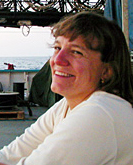A couple of weeks ago, I was invited on an “ADA (Americans with Disabilities Act) tour” of a brand new oceanographic research vessel, the R/V Sikuliaq. Commissioned by the U.S. National Science Foundation (NSF), the Sikuliaq will be operated by the University of Alaska. It’s ice-strengthened hull will allow it to work in the Arctic for much of the year.
This vessel is somewhat unique in the U.S. academic fleet in that it was designed with a number of significant accommodations for persons with disabilities. Because research vessels are not “passenger vessels” , they are not required by federal law to have access in the same ways as ferries and public transit boats (water taxis etc). But about 8 years ago, the NSF and the University National Oceanographic Laboratory System (UNOLS), the agency that is responsible for the U.S. oceanographic fleet, assembled ship operators, designers and some scientists to discuss how new research vessels could be made to be more accessible to all.The result of that meeting was a set of guidelines for new vessel construction, and the first vessel to follow those guidelines is the Sikuliaq. After my cruise this summer on the R/V Knorr, which was not built with accommodations in mind, the Sikuliaq was quite an “eye-opener” as to how my working and living environment could be made so much better. Along with several mobility, hearing and vision impaired colleagues, I wandered around the Sikuliaq noting all the ways life would be better on board. Here is a partial list of improvements:
- all rooms had tactile and braille signs outside the doors
- lighting was excellent throughout rooms and corridors
- most of the doorways had little or no thresholds, and many had buttons to open automatically. Doorways were wide enough to accommodate wheelchairs.
- the central stairway (connecting all the decks) had tactile flooring at the top and bottom of each flight of stairs, and one continuous railing
- a personnel-rated elevator connects three decks
- bright flashing lights as well as alarm bells signal an emergency
- there is a stateroom with an accessible bathrrom
- the exercise room and sauna (!) are wheel-chair accessible
There are still some challenges of course, like some boxes that stick out from the wall at head-height (a hazard for everyone!). But overall, I think the accommodations are a huge step forward, and I applaud the efforts of the NSF, UNOLS and the University of Alaska on this milestone in making science more accessible to all.

 Amy Bower is a physical oceanographer at the Woods Hole Oceanographic Institution. She has been chasing ocean currents in the Atlantic and Indian Oceans for over 25 years, primarily by releasing acoustically tracked floats far below the sea surface. Legally blind since her mid-20s, Amy uses adaptive technology to continue her research.
Amy Bower is a physical oceanographer at the Woods Hole Oceanographic Institution. She has been chasing ocean currents in the Atlantic and Indian Oceans for over 25 years, primarily by releasing acoustically tracked floats far below the sea surface. Legally blind since her mid-20s, Amy uses adaptive technology to continue her research.